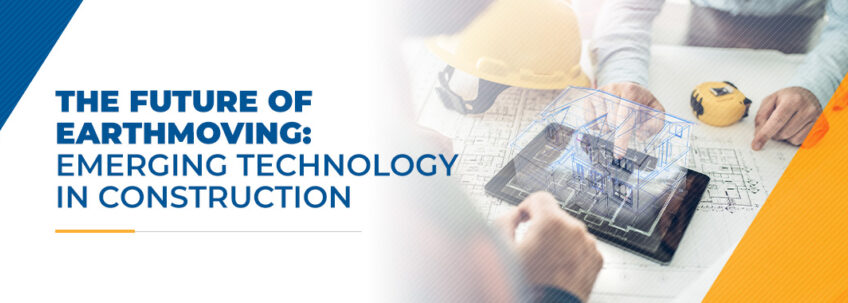Labor shortages and supply chain issues have created tension across the construction industry, making it challenging for companies to keep up with demand and stay on schedule. These challenges have impacted overall productivity and revenue, increasing the strain on construction companies. Despite these challenges, emerging technology in the construction industry is helping contractors stay competitive in the changing market.
Innovations in construction enable improvements across all construction projects, especially regarding safety, productivity and efficiency. Artificial intelligence, automation and wearable safety gear are revolutionizing construction operations and changing how future projects will be completed.
JUMP TO SECTION
How Construction Technology Is Changing the Industry
Construction engineering technology refers to innovations in construction machinery and software that improve the design and building process. New construction building technology is combating the lingering material and labor shortages and delays within the supply chain by automating parts of the workforce and increasing turnaround rates.
Emerging technologies like drones, mobile apps and virtual reality improve productivity, safety and efficiency.
7 Types of New Construction Technology to Look For
There are various types of new construction technology that contracting companies are using to change how they do business. Some of the new technology you can expect to see more of include:
1. Drones
Drones are quickly becoming more popular within the construction industry. Dones allow construction companies to conduct accurate and quick site surveys. They are also cheaper than aerial imaging, utilizing high-resolution cameras for 3D maps and models.
Drones can inspect hard-to-reach areas, such as tall buildings or bridges, without posing a risk to worker safety. Drones help monitor progress on worksites and watch for hazards like chemical spills, heavy moving objects or noise exposure before they become dangerous to workers.
2. Data Collection Apps
Data collection projects are some of the most popular apps in the construction industry. These apps make it easier to gather accurate, high-quality data because they reduce the risk of data entry errors and enhance workflow with automated data collection.
Data collection apps also improve safety compliance. These apps facilitate and automate equipment inspections, job safety analysis, near-miss reporting and other types of data reporting. Data collection apps also streamline reporting by providing instant access to reports and legal documents. These apps also enable construction companies to customize their reports with ease based on the specific needs of their business.
3. Building Information Modeling (BIM)
BIM can help improve collaboration since all parties can add their piece to the same model rather than having broken pieces on a 2D paper. BIM can also help solve challenges in the design and planning stages since the software can automate clash detection and create a complete project vision.
4. Virtual Reality
Virtual reality (VR) is often combined with BIM software so clients and construction companies can better understand complex projects. VR allows you to walk around your building design and spot flaws before the project enters the construction phase. Clients can view the design before construction, making it easier to get their input and make changes to improve client satisfaction. Having a clear image in mind about what the project should look like reduces how many last-minute changes are made in the middle of a project.
5. Wearable Technology
Wearable technology can keep workers safe from falls and equipment collisions. This technology utilizes AI and sensors to predict or detect hazardous scenarios or conditions, alerting workers and supervisors to bring attention to these hazards before they result in injury.
Some examples of wearable construction technology include:
- Smart hard hats: These hats can sense brainwaves and detect “microsleeps,” a sudden and temporary episode of drowsiness or sleep. Once a microsleep is detected, project supervisors are alerted, allowing them to remove workers from hazardous situations.
- Power gloves: These gloves can help improve a worker’s strength and dexterity, which helps reduce overuse injuries.
- Smart boots: These shoes help detect a worker’s risk of falling or collision with construction equipment. Construction equipment is equipped with compatible sensors to deliver alerts to workers when they get too close and could fall or collide with the equipment.
Another innovative piece of wearable technology is construction exoskeletons. This technology is equipped with motorized joints, which provide additional power and support when workers make repetitive motions, such as grabbing, lifting or bending. Some exoskeletons are powered by electricity, while others help redistribute weight to other body parts. Exoskeletons come in various configurations and sizes, such as full-body suits that help reduce fatigue and enhance strength for challenging lifting jobs.
6. Artificial Intelligence (AI) and Robots
AI learns from past experiences and can make decisions without human input based on how it was programmed. AI can analyze data and make quick decisions that improve safety in the workplace by identifying risks and safety violations, such as the potential for hazards like chemical spills or falls. This technology can also solve these challenges by using past data and decisions to make improvements to current safety protocols. Additionally, AI is capable of analyzing building design aspects and improving them by utilizing its expansive database to create variations.
Construction robots are another technology that is becoming more popular on construction sites. These robots are helping address labor shortages — factory robots can complete repeated warehouse tasks, and fully autonomous robots are capable of scanning the work environment and performing complex tasks with their pre-equipped tools.
Construction robots can also improve worker safety by taking jobs that can be dangerous or hazardous to humans. While robots aren’t widely adopted in construction, they’re becoming more popular each year and may rise to the popularity of drones or other innovative technology.
7. 3D Printing
3D printing creates structures and components by layering materials until the desired product is created. Some companies have made entire homes through 3D printing. Some ways that 3D printing will change the construction industry include:
- Reducing errors: 3D printers can render a design perfectly in the real world, reducing the risk of costly errors affecting budgeting and project schedules.
- Increasing speed: 3D printed structures can be completed in just a matter of days, which can speed up construction processes and help with delays caused by shortages.
- Improving efficient material usage: 3D printing can help reduce total waste since most materials are used in the printing process. Unused materials can be repurposed for other printing projects.
3D printing is a revolutionary technology that is changing how the construction industry works, and more companies are adopting the technology after seeing its impressive capabilities.
Contact SITECH Southwest for Construction Technology Solutions
Technology will continue to have a massive impact on the construction industry, streamlining processes and improving workers’ safety. SITECH Southwest offers construction management technology to help improve your productivity and increase your profit. We can integrate innovative technology solutions for your entire construction site, allowing your project to stay on track.
Some of our technology solutions include machine control systems, software solutions and site positioning systems. Contact us today to learn more about how we can help you revolutionize your construction business.



